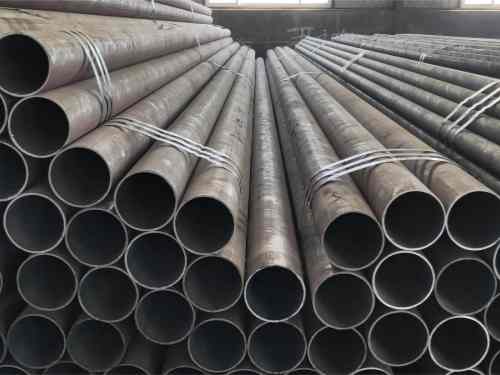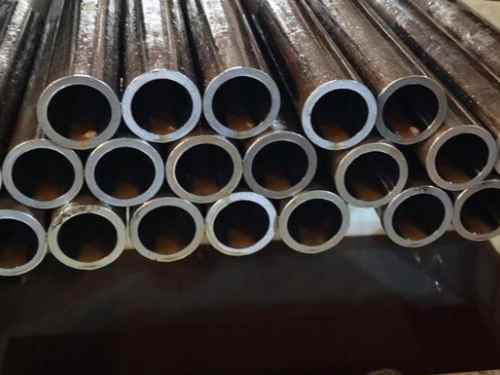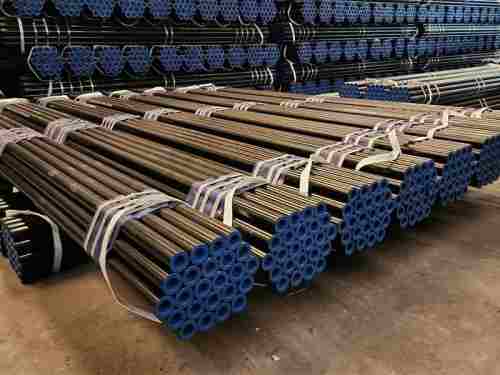Carbon steel pipes (CS pipes) are iron–carbon alloy pipes whose temperature suitability depends on material grade, manufacturing quality, and service conditions. Under standards such as ASTM A106 and ASTM A53, the typical safe operating temperature range is –29°C to 425°C.
Temperature Range of Carbon Steel Pipes
- Low-Temperature Limit (–29°C)
Below –29°C, the toughness of carbon steel drops rapidly, increasing the risk of brittle fracture.
For subzero service, pipes that pass low-temperature impact tests—such as ASTM A333 Grade 6—are required.
- High-Temperature Limit (425°C)
Above 425°C, carbon steel suffers from accelerated oxidation, strength loss, and potential creep deformation.
High-temperature applications should use chromium–molybdenum alloy steels (e.g., ASTM A335 P11).
Influence of Temperature on Pipe Performance
- Mechanical Property Changes
High temperatures: Yield and tensile strength decline. For instance, the tensile strength of 20# carbon steel drops by about 15% at 300°C.
Low temperatures: Steel may become brittle and must be verified using Charpy V-notch impact tests (e.g., ≥27 J at –46°C).
- Corrosion Behavior Differences
High temperatures: Oxidation accelerates; above 425°C, external treatments such as aluminizing or galvanizing are recommended.
Low temperatures: Condensation can trigger electrochemical corrosion, necessitating better insulation or protective coatings.
Temperature Requirements in Specific Applications
Boilers and High-Pressure Steam Systems
ASME guidelines allow carbon steel pipes to briefly exceed 450°C in high-pressure steam service, but wall-thickness reduction and long-term creep behavior must be monitored.
|
Application
|
Temperature (°C)
|
Material Recommendations
|
|
Conventional Steam Piping
|
≤ 425℃
|
Carbon Steel (A106)
|
|
Superheated Steam
|
425–580℃
|
Cr-Mo Alloy Steel (P11 / P22)
|
|
Supercritical Boilers
|
> 580℃
|
High Cr Alloy or Austenitic Stainless Steel
|
- Cryogenic Storage and Transportation Equipment
LNG pipelines and other cryogenic scenarios (-162°C) require austenitic stainless steel or nickel-based alloys. Carbon steel pipes are only suitable for secondary insulation layer support structures.
|
Temperature
|
Available Materials
|
|
-29℃ ~ -46℃
|
Low-temperature carbon steel (A333)
|
|
-46℃ ~ -196℃
|
304/316L Stainless steel, nickel-based alloys
|
|
-162℃ LNG mainline
|
Austenitic stainless steel as the primary material
|
Temperature Requirements for Different Standard Carbon Steel Pipes
|
Standard
|
Type
|
Minimum Operating Temperature
|
Maximum Operating Temperature
|
Features
|
|
ASTM A53
|
Ordinary carbon steel pipe
|
-29℃
|
415–425℃
|
General piping, building applications
|
|
ASTM A106
|
High-temperature carbon steel pipe
|
-29℃
|
425℃
|
High-temperature steam, pressure systems
|
|
ASTM A333 Gr.6
|
Low-temperature carbon steel pipe
|
-46℃
|
260℃
|
Excellent low-temperature impact performance
|
|
ASME B31.3
|
Fluid piping specification
|
-29℃(ordinary carbon steel)
|
425℃ (ordinary carbon steel)
|
Authoritative engineering standard
|
|
ASTM A335 P11/P22
|
Cr-Mo alloy steel
|
-
|
540℃
|
High temperature and high pressure conditions
|
Use of Carbon Steel Pipes in Extreme Temperatures
- Temperatures ≥ 400°C
For service conditions at or above 400°C, standard carbon steel is not recommended.
Use P11 or P22 alloy steel, and consider increasing wall thickness or reducing allowable stress to ensure long-term stability.
- Temperatures ≤ –29°C
Ordinary carbon steel is unsuitable due to brittle behavior.
Replace with low-temperature carbon steel, such as ASTM A333 Grades, which are designed for subzero impact toughness.
- Frequent Temperature Fluctuations
Applications with repeated heating and cooling cycles pose a risk of thermal fatigue cracking.
Select materials with higher toughness, and for environments where corrosion and high temperature are both present, use a coating + alloy steel composite design for dual protection.
FAQ
- What is the maximum temperature carbon steel pipes can withstand?
Long-term continuous service: up to 425°C
Short-term excursions: up to 450°C, as allowed by ASME for specific steam and pressure systems
- Can carbon steel pipes be used for LNG (–162°C)?
No.
Carbon steel cannot provide the required toughness at –162°C. Austenitic stainless steel is mandatory for LNG process pipelines; carbon steel may only be used in non-cryogenic auxiliary structures.

 English
English Español
Español











